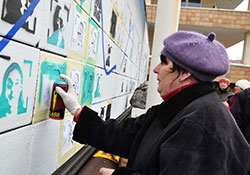Bridging the generation gap in Prague, Czech Republic

WHO/Malin Bring
It is a windy and overcast afternoon in the suburban area known as Prague 4; a district with several high blocks of flats and a large number of inhabitants above the age of 60. In front of the long, whitewashed wall that leads up to the Elpida senior citizen centre, a mixed group of people are gathered. Tea and sweets are being served from a table on the lawn, and a few metres away a young man is playing the saxophone. It is a festive day at the centre.
“It’s wonderful that young and old people can meet like this. We’ve shown everyone that we’re not too old to do this graffiti stuff!” says an enthusiastic Antonin Rückl, a gentleman of 67, wearing a corduroy cap and a nylon jacket zipped right up to his chin for warmth. He has just finished carefully spray-painting his own portrait with bright turquoise paint onto the wall, and is now standing back to admire the result.
Painting a better picture of the older generation
Three young men from a neighbouring graphic high school are instructing the assembled group in the technique. Some time ago everyone present had their photographs taken. The students subsequently transformed the black-and-white images into simplified cut-outs of equal size, to be used as templates for spraying the portraits onto the wall. The project has been so popular that it had to be prolonged. When complete, the wall display no less than 537 portraits of staff and visitors of the senior centre, young as well as old.
“This is one of the projects we have carried out to try and tear down the barriers between different generations,” says Jiri Hrabe, public relations manager at Elpida. Older people are frequently portrayed negatively in the Czech media, he feels. More often than not they are described as a burden to their children and of little use to society in general. To change this image, Elpida publishes Vital Plus, a quarterly magazine with a “non-stereotypical representation of the elderly generation” as Jiri Hrabe puts it. The magazine deals with health, education and social issues and is distributed freely to readers all over the country. “For the time being we can only afford to print 12 000 copies, but they’re spread from hand to hand like the illegal literature of Soviet times,” says Jiri Hrabe, who is the magazine’s editor-in-chief, with a grin.
On the lawn in front of the many-faced wall at the entrance, the graffiti painters are about to finish the afternoon’s art work. The two sisters Jirina Kralova, 74, and Vera Stropnicka, 68, are taking in the scene while sipping a glass of tea. They have not taken part in the event but have come to watch, after having heard about it on TV. “This is something new and interesting, we thought. I’ve taken an internet class here at Elpida, so I know the place well,” says Jirina Kralova. Her sister finds it a good idea to integrate the young with the elderly –“it can sometimes be difficult,” she nods, and they both hope there will soon be another opportunity to spray-paint their portraits, so they can have a go.
“Every granny is going to want to see her picture on a wall from now on!” declares Jirina Kralova, emptying her tea glass.



